kuro96inlaila
Hazard to Self
 
Posts: 96
Registered: 21-6-2010
Location: Malaysia
Member Is Offline
Mood: Quietly thinking
|
|
Manganese compound?
Few days ago,I was grinding a mixture of potassium permanganate and glucose in granite mortar.Then I use the mixture and left the mortar for a day.The
colour of the residue is dark brown,before I left it it was a bit whiter because of glucose.
My theory is some of the glucose had reduce the potassium permanganate to Manganese dioxide.Then I took the mortar to the sink and wash it with
water.The water turn deep violet indicating potassium permanganate is still there,but leaving a dark area........guess it is manganese dioxide.Ok,in
order trying to get rid of that stain,I pour in bleach (sodium hypochlorite).
After the next day,I pour the bleach that I left in my granite mortar and I receive this odd coloured solution(pictured),Is this a compound of
manganese or just solution of potassium permanganate?
(I'm sure that I wash the mortar untill all the potassium permanganate dissolved)
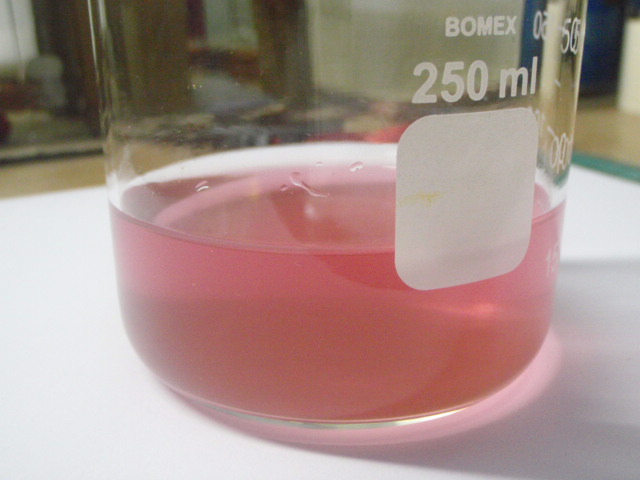
|
|
|
Ozone
International Hazard
    
Posts: 1269
Registered: 28-7-2005
Location: Good Olde USA
Member Is Offline
Mood: Integrated
|
|
You are lucky that mixture did not catch fire or worse when you were grinding it. Carbohydrate- permanganate mixtures are notorious. I have set
mixtures of table sugar (sucrose) and permanganate off by tapping with a hammer. Apparently a flash mixture can also be so made.
The dark brown was MnO2. Although I have generated MnO4 from MnCl2 via bleach (NaOCl), which was verified by UV-Vis spectroscopy, your mix looks like
MnCl2 with maybe a*trace* of MnO4 (provided that the color saturation of the photo is good). It might be of interest to add further NaOCl and see
what happens.
What was your stoichiometry?
Cheers,
O3
[Edited on 19-8-2010 by Ozone]
-Anyone who never made a mistake never tried anything new.
--Albert Einstein
|
|
|
12AX7
Post Harlot
    
Posts: 4803
Registered: 8-3-2005
Location: oscillating
Member Is Offline
Mood: informative
|
|
Too strong to be MnCl2.
I'd put my money on MnO4-. Bleach is strong stuff.
Next time, go for H2SO4 + H2O2 -- peroxide is an excellent reducing agent around manganese. Go easy with it, just a few drops of peroxide at a time!
Tim
|
|
|
Bezaleel
Hazard to Others
  
Posts: 444
Registered: 28-2-2009
Member Is Offline
Mood: transitional
|
|
I agree with 12AX7, even the strongest concentration of MnCl2 solution has a much lighter colour. Probably it's mixed with a trace of KMnO4.
|
|
|
kuro96inlaila
Hazard to Self
 
Posts: 96
Registered: 21-6-2010
Location: Malaysia
Member Is Offline
Mood: Quietly thinking
|
|
Quote: Originally posted by Ozone  | You are lucky that mixture did not catch fire or worse when you were grinding it. Carbohydrate- permanganate mixtures are notorious. I have set
mixtures of table sugar (sucrose) and permanganate off by tapping with a hammer. Apparently a flash mixture can also be so made.
[Edited on 19-8-2010 by Ozone] |
I do concern about that risk Ozone,that mix sparks a few time when I grind it.
I try to precipitate manganese carbonate with sodium carbonate solution.And I get this result(pictured).I gues the brown precipitate is manganese
carbonate.the solution stay pink,so maybe Bezaleel theory is right,it was contaiminated with KMnO4.Therefore,this thing come from my mortar washing's
water . .
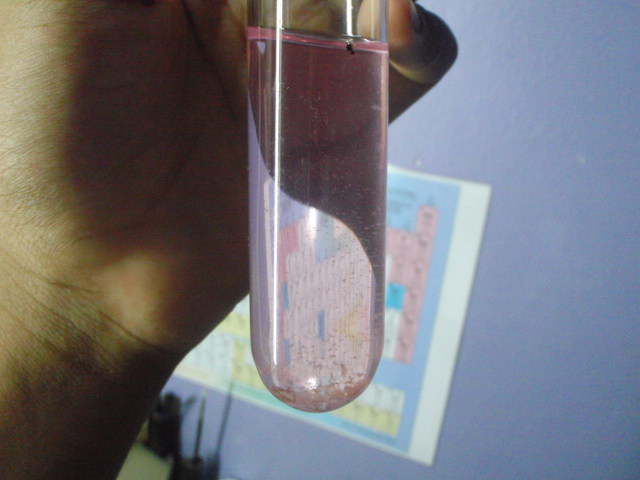 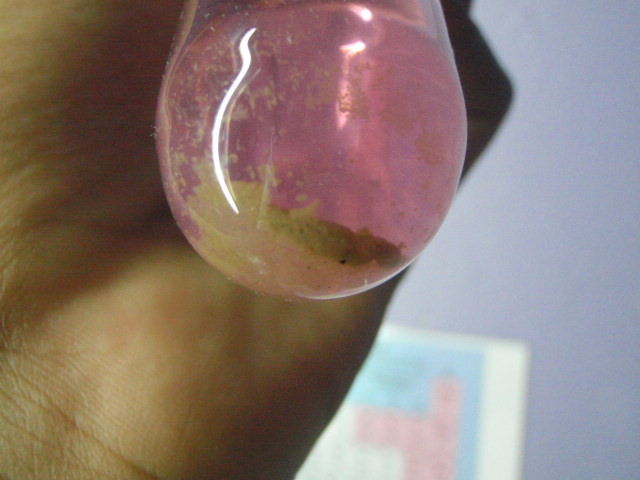
12AX7,thanks for your tips.I'll try that later.......but the sad thing is,I have no hydrogen peroxide with me now ......I have see a video about making manganese sulfate.but,manganese chloride can be made by similar way I gues,here
the link: ......I have see a video about making manganese sulfate.but,manganese chloride can be made by similar way I gues,here
the link:
http://www.youtube.com/watch?v=2gXByJkg0iY
Got to try it,seem interesting to me . .
[Edited on 19-8-2010 by kuro96inlaila]
|
|
|
blogfast25
International Hazard
    
Posts: 10562
Registered: 3-2-2008
Location: Neverland
Member Is Offline
Mood: No Mood
|
|
Quote: Originally posted by Ozone  | You are lucky that mixture did not catch fire or worse when you were grinding it. Carbohydrate- permanganate mixtures are notorious. I have set
mixtures of table sugar (sucrose) and permanganate off by tapping with a hammer. Apparently a flash mixture can also be so made.
The dark brown was MnO2. Although I have generated MnO4 from MnCl2 via bleach (NaOCl), which was verified by UV-Vis spectroscopy, your mix looks like
MnCl2 with maybe a*trace* of MnO4 (provided that the color saturation of the photo is good). It might be of interest to add further NaOCl and see
what happens.
What was your stoichiometry?
Cheers,
O3
|
Right on both accounts.
On the first part, the amount of heat of oxidation of sucrose with KMnO4 must be quite phenomenal (see also glycerol + KMnO4 as initiator mix for
Thermites). Here's two experiments estimating the amount of heat generated by a related reaction: oxidation of ethanol with K2Cr2O7 and with KMnO4:
http://www.sciencemadness.org/talk/viewthread.php?tid=12832&...
As regards the colour being due to MnO4-, absolutely. I used to get it systematically when oxidising Mn [+II] to MnO2 with bleach. I too used to think
the pink was due to MnCl2 but it was MnO4-. MnCl2 is only really slightly pink as the solid hydrate.
|
|
|
kuro96inlaila
Hazard to Self
 
Posts: 96
Registered: 21-6-2010
Location: Malaysia
Member Is Offline
Mood: Quietly thinking
|
|
As the conclusion,the pink colour was manganate ion,not being manganese chloride ..........I plan to do experiment using bleach and lab reagent grade manganese dioxide and I'll report the result later. ..........I plan to do experiment using bleach and lab reagent grade manganese dioxide and I'll report the result later.
|
|
|
kuro96inlaila
Hazard to Self
 
Posts: 96
Registered: 21-6-2010
Location: Malaysia
Member Is Offline
Mood: Quietly thinking
|
|
Ok,here is the result:
I pour 15ml of bleach into testube and put about 8g of manganese dioxide into it.I also prepare similar mixture but in bigger amount in 250ml
beaker.The mixture bubbled but I cannot identify what gas it is:
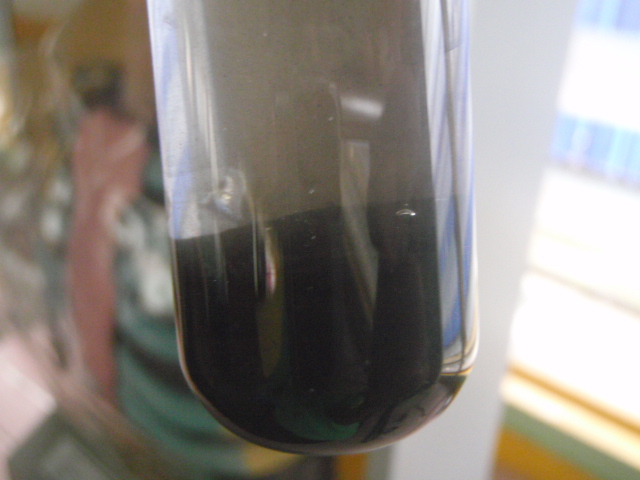
As I swirl the testube,the reaction become faster,but it come back bubbling smoothly not long after i stop swirling the testube.Then I let it sit
until the evening of that day.
At the evening:The reaction is still proceeding.but the solution is pink(damn camera,you take it purple).
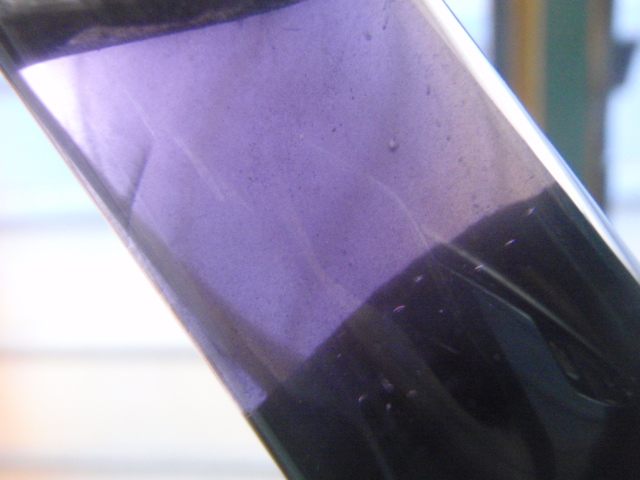
Then I leave the reaction going without disturbing it,until the completion.I dont know the exact time when the reaction actually come to the end.I
come to it after about two days later(Forgot about the experiment though ).I got
these result: ).I got
these result:
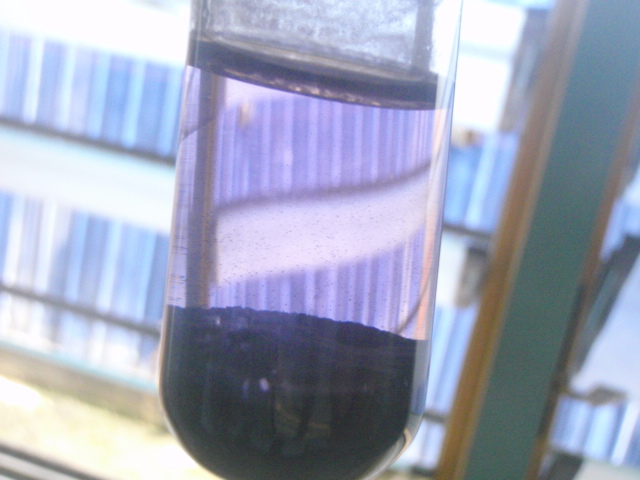
Ok,that is actually faint pink.Maybe manganese chloride have been form.Meanwhile at the beaker:
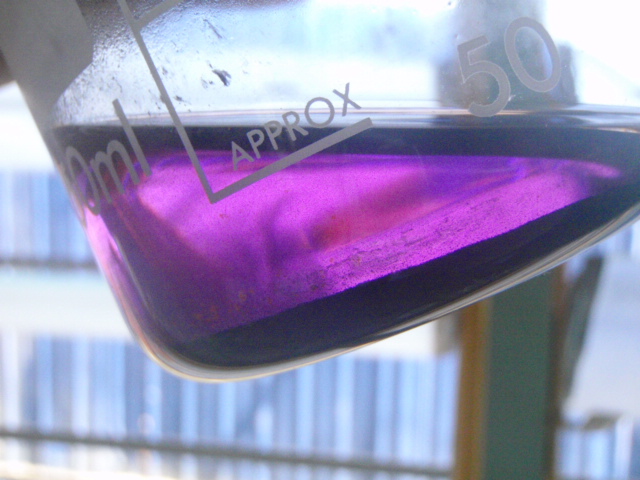
HARGH!!!WHAT IS THIS THING!!!The solution was intensely purple like permanganate ions.Does permanganate can be form from this.Wikipedia say that
sodium permanganate can be prepared by the reaction of manganese dioxide with sodium hypochlorite:
2 MnO2 + 3 NaClO + 2 NaOH → 2 NaMnO4 + 3 NaCl + H2O
I think cations and anions ions test should be made to figure what compound is this........What do you think of this (the whole experiment) my fellow
friends?
|
|
|
12AX7
Post Harlot
    
Posts: 4803
Registered: 8-3-2005
Location: oscillating
Member Is Offline
Mood: informative
|
|
Yes, that's a weak permanganate solution.
Unfortunately, the yield is low, so you're looking at very little. It's not practical to produce permanganate in this way. But it does occur, as you
can see.
Tim
|
|
|
woelen
Super Administrator
        
Posts: 7977
Registered: 20-8-2005
Location: Netherlands
Member Is Offline
Mood: interested
|
|
Bleach indeed is a very powerful oxidizer. You can make permanganate with it and even ferrate ion:
http://woelen.homescience.net/science/chem/exps/bleach/index...
With a little heating you can get somewhat stronger permanganate solutions, as the picture shows. But still, the solution is VERY dilute. Permanganate
ion has a very strong color, so even very dilute solutions still show a strong color. Nice for a demo, but not useful for synthetic purposes.
|
|
|